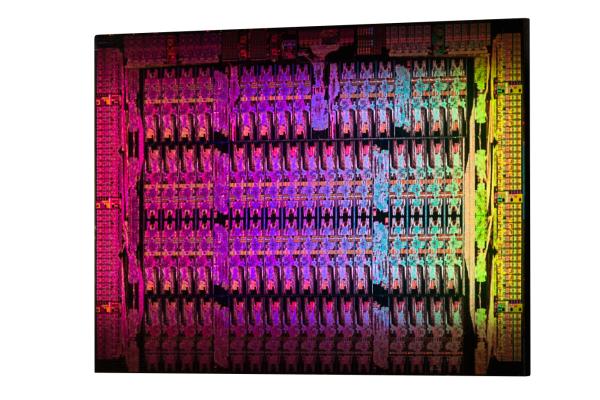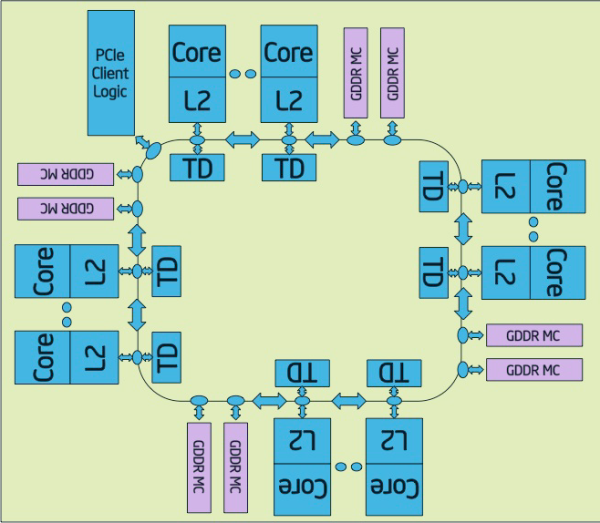The Xeon Phi at work at TACC
by Johan De Gelas on November 14, 2012 1:44 PM EST- Posted in
- Cloud Computing
- CPUs
- IT Computing
- Intel
- Larrabee
- Xeon
- Xeon Phi
The Xeon Phi family of co-processors was announced in June, but Intel finally disclosed additional details.The Xeon Phi die is a massive chip: Almost 5 billion transistors using Intel's most advanced 22nm process technology with 3D tri-gate transistors.
A maximum of 62 cores can fit on a single die. Each core is a simple in order x86 CPU (derived from the original Pentium) with a 512-bit SIMD unit. There is a twist though: the core can handle 4 threads simultaneously. Nehalem, Sandy and Ivy Bridge also use SMT, but those cores uses SMT mostly to make better use of their ample execution resources.
In case of the Xeon Phi core, the 4 threads are mostly a way to hide memory latency. In the best case, two threads will execute in parallel.
Each of these cores is a 64-bit x86 core. However, only 2% of the core logic (excluding the L2-cache) is spent on x86 logic. The SIMD unit does not support MMX, SSE or AVX: the Xeon Phi has its own vector format.
All of the cores are connected together with a bi-directional ring, similar to what's used in the Xeon E7 and the Sandy Bridge EP CPUs.
Eight memory channels (512-bit interface) support up to 8 GB of RAM, and PCIe logic is on chip.












46 Comments
View All Comments
Kevin G - Saturday, November 17, 2012 - link
It is dependent upon the bus encoding. PCI-E 1.0/2.0 use an 8/10 encoding scheme to handle traffic while PCI-E 3.0 uses 128/130 encoding. PCI-E only increases the clock speed of the bus by 66% with the rest of the bandwidth increase stemming from the more efficient encoding schema. Xeon Phi seems to have kept the PCI-E 1.0/2.0 encoding but supports the higher clock rate of PCI-E 3.0. This appears to be nonstandard but the LGA 2011 Xeons appear to support this for additional bandwidth.Any overhead is likely adding full PCI-E 3.0 support in addition to PCI-E 1.0/2.0.
mayankleoboy1 - Thursday, November 15, 2012 - link
Assuming you can buy a single Xeon phi card, can it work in desktop motherboards and processors ?Can it work with AMD processors ? Can it work in tandem with Nvidia and ATI GPU's ?
Joschka77 - Thursday, November 15, 2012 - link
i think the answers would be: Yes, Yes, no! ;-)Jaybus - Thursday, November 15, 2012 - link
No, it is yes, yes, and yes. The Stampede also uses 128 NVIDIA Tesla K20 GPUs, as stated in the article.Kevin G - Saturday, November 17, 2012 - link
That's with in the cluster, not necessarily in the same host system. I strongly suspect that the visual nodes featuring K20 GPU's are isolated from the Xeon Phi nodes.maximumGPU - Thursday, November 15, 2012 - link
can't deny that openMP code that automatically runs faster on the phi would represent a great solution for those looking for the speed up without the cost and time of modifying code for gpus. There certainly is a market to cater for with these cards.creed3020 - Thursday, November 15, 2012 - link
Johan,The numbers you describe as to configuration of the units doesn't add up.
Eight of the compute sleds plus two PSU sleds cannot fit into a 4U unit. Judging by the photo it appears that in this vertical configuration of nodes it goes something like this: {Compute, Compute, PSU, PSU, Compute, Compute } 4U. It appears this leads to a total of 5 chassis per cluster within the rack.
This is then compounded with two distinct clusters per rack with their own Infiniband switch + regular Ethernet switch. This makes for a total of 10 C8000 chassis per rack.
This makes sense when considering a 48U rack. 22U per cluster x 2 clusters per rack = 44U with a few spare slots at the top and middle. I could two at top and one in the middle.
llninja1 - Thursday, November 15, 2012 - link
I think the author got some Dell facts mixed up. Looking at Dell.com you can fit 8 compute sleds in, but those compute sleds are half width and don't contain the necessary double wide PCIe slots to accommodate a Xeon Phi card. So in a single 4U unit, you are correct it can only hold 4 compute sleds and two power units as depicted in the Stampede picture.creed3020 - Friday, November 16, 2012 - link
Thanks for the explanation. I didn't go over to the Dell site but it would explain that a slimmer sled is possible if you don't have to stick one these huge 2 slot Xeon Phi cards in.It makes me wonder how big a difference there is in total PFLOPS/rack when configured with the half height sled vs. full height sled with Phi.
mfilipow - Thursday, November 15, 2012 - link
"Eight of those server sleds find a home inside the C8000 4U Chassis, together with two power sleds." did you write - but on the photo I only see 4x computing sleds plus 2x power. Where are the other 4?!